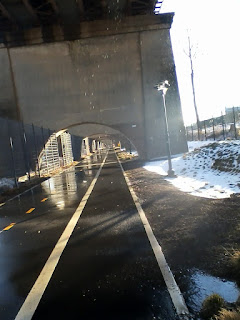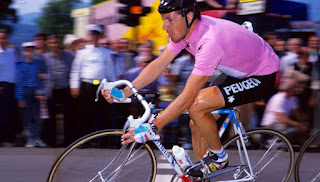I am an educator. It's still strange for me to write those words. You see, I resisted becoming one and quit for a few years when I was having a midlife crisis. I then realized that I didn't need to change jobs: I only had to change my gender.
Anyway, one of the reasons I tried not to become a teacher (which was the only kind of educator I knew about) was that I hated most of my teachers. I guess that's not so unusual because, well, most kids hate their teachers and some of my elementary-school teachers were Carmelite nuns. Yes, they wore the black habits.
I did, however, have teachers I liked, and not necessarily because they were "easy". Rather, I realize now that they "got" me: I wasn't the best-behaved or smartest kid, butI wasn't destructive and I loved to read and write. So they encouraged me in those areas and even showed interest in whatever happened to interest me at the time.
Cycling wasn't one of those interests, though. It wasn't that I didn't like to ride: The reason why they couldn't help or encourage me in those areas is that none of them rode. Actually, through all of my pre-adult life, adults didn't ride bikes and most assumed that a kid would "grow out of it", probably upon getting his or her driver's license, or not long after.
Now, I don't know whether South Carolina elementary-school teacher Katie Blomquist pedals to her school, or anyplace else. But she surely understands how much having a bike means to her kids. She also knew that many of them, or their families, couldn't afford one.
So, last summer, she decided she would play Santa Claus and make sure all of the kids in her school got a bike for Christmas. She started a GoFundMe campaign that would raise $80,000. Donations came from as far away as France and Australia. In the meantime, she worked with a local bike shop called Affordabike to pick out color schemes and other aspects of the bikes. Affordabike also provided the kids with matching locks and helmets.
Katie's Kids, if you will, didn't get their bikes for Christmas. But yesterday the bikes, helmets and locks were delivered to the Pepperhill Elementary School in North Charleston, South Carolina. The largesse wasn't limited to the pupils of her class: All 650 Pepperhill pupils received the bikes, helmets and locks.
So, while they didn't get the Christmas gift every kid dreams of, their wheels are ready for the beginning of spring break--and summer.
Pepperhill is a Title 1 school, which means that it receives extra funding from the Federal government for its students, many of whom come from low-income families. But, for a day, they were all equal in the wealth of happiness they experienced--and the kindness of a teacher they, I am sure, will always recall fondly!
Anyway, one of the reasons I tried not to become a teacher (which was the only kind of educator I knew about) was that I hated most of my teachers. I guess that's not so unusual because, well, most kids hate their teachers and some of my elementary-school teachers were Carmelite nuns. Yes, they wore the black habits.
I did, however, have teachers I liked, and not necessarily because they were "easy". Rather, I realize now that they "got" me: I wasn't the best-behaved or smartest kid, butI wasn't destructive and I loved to read and write. So they encouraged me in those areas and even showed interest in whatever happened to interest me at the time.
Cycling wasn't one of those interests, though. It wasn't that I didn't like to ride: The reason why they couldn't help or encourage me in those areas is that none of them rode. Actually, through all of my pre-adult life, adults didn't ride bikes and most assumed that a kid would "grow out of it", probably upon getting his or her driver's license, or not long after.
Now, I don't know whether South Carolina elementary-school teacher Katie Blomquist pedals to her school, or anyplace else. But she surely understands how much having a bike means to her kids. She also knew that many of them, or their families, couldn't afford one.
So, last summer, she decided she would play Santa Claus and make sure all of the kids in her school got a bike for Christmas. She started a GoFundMe campaign that would raise $80,000. Donations came from as far away as France and Australia. In the meantime, she worked with a local bike shop called Affordabike to pick out color schemes and other aspects of the bikes. Affordabike also provided the kids with matching locks and helmets.
Katie's Kids, if you will, didn't get their bikes for Christmas. But yesterday the bikes, helmets and locks were delivered to the Pepperhill Elementary School in North Charleston, South Carolina. The largesse wasn't limited to the pupils of her class: All 650 Pepperhill pupils received the bikes, helmets and locks.
So, while they didn't get the Christmas gift every kid dreams of, their wheels are ready for the beginning of spring break--and summer.
Pepperhill is a Title 1 school, which means that it receives extra funding from the Federal government for its students, many of whom come from low-income families. But, for a day, they were all equal in the wealth of happiness they experienced--and the kindness of a teacher they, I am sure, will always recall fondly!




























